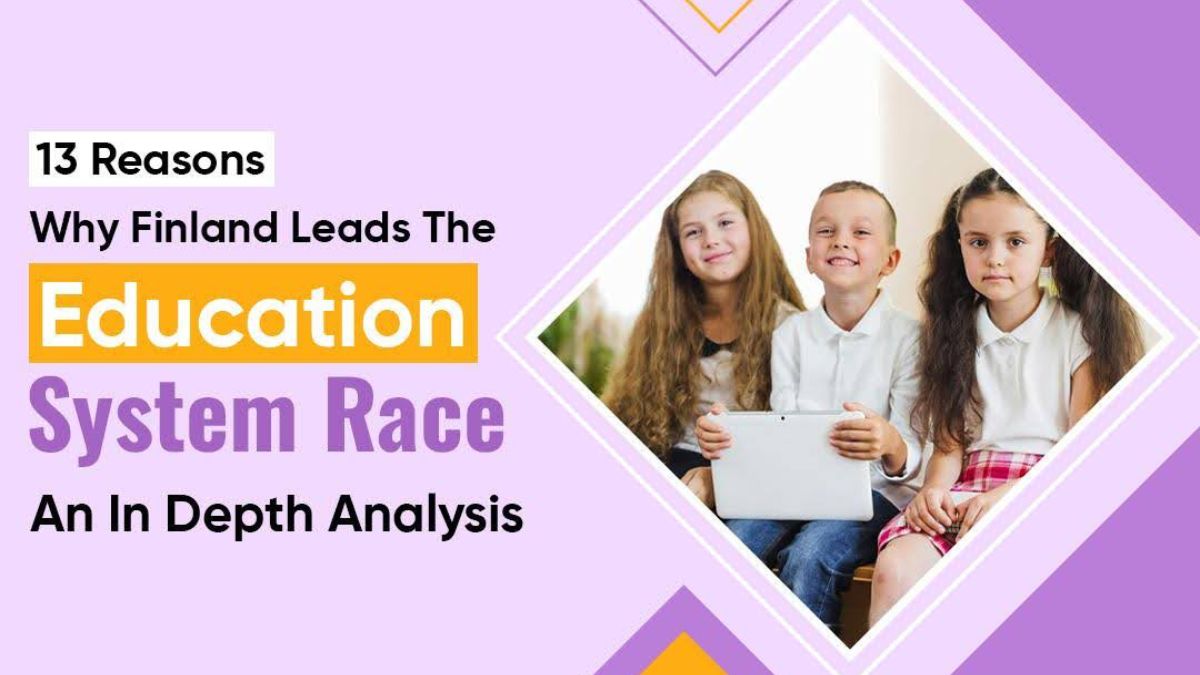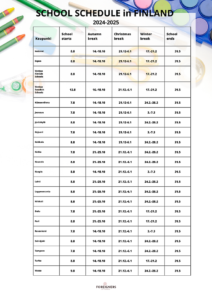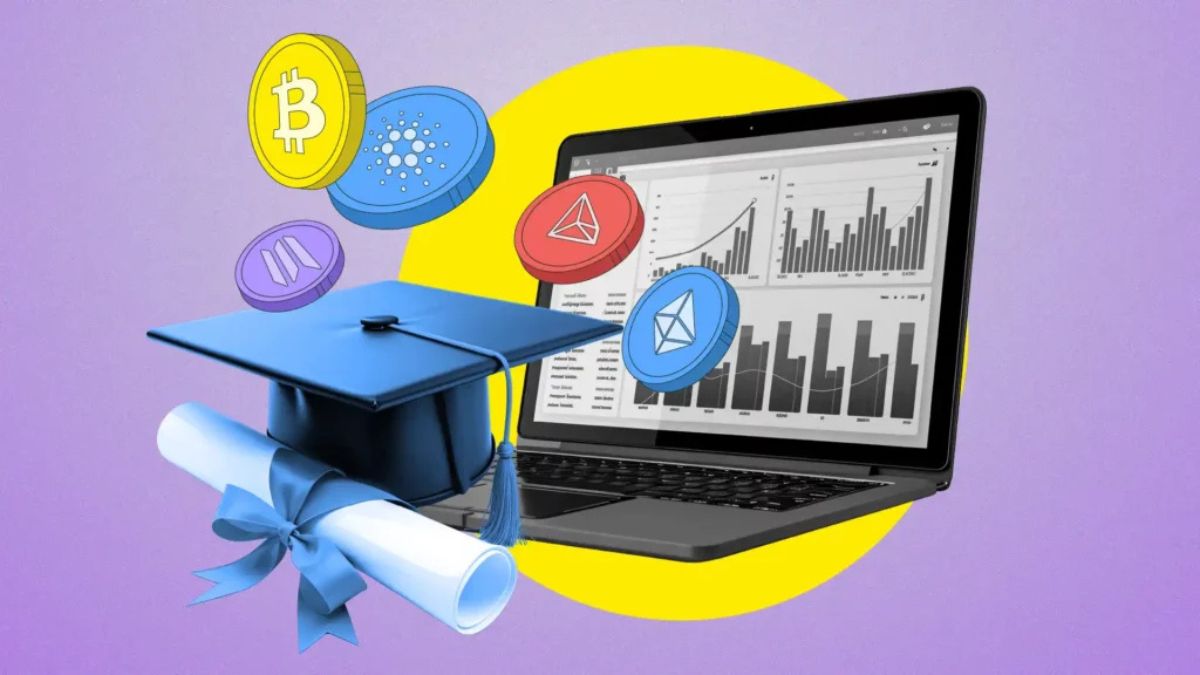EDUCATION
13 Reasons Why Finland Leads the Education System Race – An In-Depth Analysis

Finland is often considered a leader in the race of education systems due to its emphasis on holistic learning, strong focus on equity and highly trained teachers. Around 93% of students in Finland graduate from high school as per Education Corner. The rate of graduating students is higher than that of the US.
Finnish students can produce high academic results each year because there is no standardised testing and no pressure on ranking systems. This country is considered an academic paradise where students do not start formal education until they turn seven.
In this article, we shall study in detail the top 13 reasons that make Finland’s education system the best among all other educational systems around the globe. You can get a critical analysis of the reasons in this piece of writing.
Let’s get started.
Why Finland Is Considered the Best Education System? 13 Best Reasons
Finns are incredibly proud of their learning system, and no wonder their education is entirely free – starting from preschool to the time of university. This means that up to your doctoral degree, your entire education will be free, and the government will bear all the expenses. Not only this, but several other factors make the Finland Education system the best in the entire world.
Finnish education is of high quality, and the goal is for everyone to have an equal opportunity to receive the best education. It also makes them ready to tackle several opportunities for improving quality education and growing up to become active citizens.
Let’s explore these details in further depth.
-
Shorter School Days
According to Foreigners in Finland, the students of first to sixth grade usually have a shirt school day of about 21-25 hours per week. In comparison, the students of the 7 to 9 grades have an average work of 30 hours per week. The final school hours can be decided by the school itself. There are also some of the traditional afternoon clubs on the premises of the school for the 1st to 3rd grades and these are usually organised by the Lutheran church.
It may be interesting to hear, but for every 45 minutes of studying and learning, students are allowed 15 minutes of play and other activities with each other. School is only considered compulsory for 11 years, so the learners can leave their studies at 18. If they face issues with their academics, they can ask for prompt help from a legitimate assignment writing service provided by professional resources.
After the age of 18, everything is optional for students. It is considered important because such measures prepare students for the real world. They can also grow their skills and learn the skills which can help them in real life.
-
No Standardised Testing
Standardised testing students to test their comprehension level for different subjects. Their ability to answer the pre-canned questions is checked and it decides if students have a mastery over the given subject or not. What often happens is that students also learn to just to cram just to pass a test and teachers only teach to enable students to pass their tests. Due to this, the entire element of learning goes out of the equation.
The Finland education system is considered the best in the world because there is no standardised testing. The only exception to the rule is the National Matriculation Examination which is more like a voluntary test for students at the end of their upper-secondary school education.
Alternatively, all the children studying in Finland are usually graded by a grading system set by their teachers or on some other individualised basis. This way, as per the World Economic Forum, the Ministry of Education tracks the overall progress of students. They select some sample groups from different ranges of schools and check their understanding of different educational concepts.
-
A Safe Journey to School
In Finland, even young children can safely travel back to school alone or with friends. Usually, the school is close to the home of students it can accessed easily through a walk or cycle. If the student is in pre-school and you live more than 5km away from your school, the municipality of your home can arrange the transport to your home. It will also happen if your journey is deemed to be too difficult in the area you live.
Sometimes, the municipal authorities also offer free rides to younger students covering a distance of 3 kilometres as per This Works. However, the older students usually get a paid allowance when their trip is more than 7 kilometres. Overall, the journey of students towards the school is usually safe and secure.
-
Free School Lunch
Most schools in Finland offer several nutritious lunches to students, but the food itself might be a source of culture shock for foreign students. Their buffet usually consists of salad, potatoes, rice or some other kind of meat, fish or vegetarian meal to choose from. The children are allowed to drink water or skimmed milk. When planning the school meal for a kid, the government considers the allergies, ethics and religious aspects of the child under consideration.
The entire environment of the school lunch provides students with an opportunity to learn about their growth and well-being. They also learn a lot about their well-being and development, as well as interesting aspects of Finnish food culture. This structured approach to school meals is one of many factors that make Finland’s education system unique.
As part of their dissertation topic in education, many students explore how Finland’s policies on school nutrition contribute to academic performance and student well-being. Understanding these policies can provide valuable insights into the broader success of the Finnish education model. Students are not served snacks until they have a more extended school day or want to go on a class trip.
-
The School Schedule
Finland is among those countries in the world that use The Gregorian calendar and the world takes it as the most widely used civil calendar. According to Foreigners in Finland, the Finnish National Agency for Education translated the school schedules into English. The programs also include the dates of the working days and holidays of the schools.
In Finland, school starts in August, and the autumn holidays start in the third week of December. The winter holiday also begins in February, and school ends on the first week of June or the last week of May. In the following schedule, 1.5 is the first day of the fifth month.

Overall, the school schedule in Finland is not as hectic as in other nations. Generally, the students do not have to follow a specific dress code and can join the school without feeling overwhelmed or burdened with the academic chores. This is why, the graduation rate is quite high in the Finland education system.
-
All Schools are Good Schools
In Finland, every school is considered a good school; it’s more like a Finnish principle. Students do not wear uniforms in the schools of Finland and they can dress however the way they like in school. Almost without any kind of exception, the children start their schools at local schools.
The terms of institution and the holiday times vary slightly between different kinds of municipalities, but everyone has the same number of off days at school per year. Usually, the holiday season lasts for two weeks; furthermore, you will get 2.5 months off in the school over the summer.
When studying at a Finnish school, there will be some days of the holiday season when autumn comes, and there will also be a week-long holiday in the springtime or term. Although the latter is usually known as the ‘ski holiday’, you will not have to ski; essentially, you can enjoy your vacation season however you want.
-
Same Teachers
The Finnish students have to learn from the same instructor for up to six years of their school career, as Education Corner reported. The students can get all the support based on their personal needs.
The Finland education system believes that every child has unique and individual needs, so getting special education is important for everyone. The ‘same teacher’ policy is a strong pillar of the harmonious education environment of the students of Finland.
It also allows the students to grow their relationship with their teachers and fosters deeper respect and trust. The Finnish students can have a high level of faith in their teachers and in their overall education system.
-
The Role of Teachers
The part played by teachers in Finland education system is considered autonomous. It means that teachers are considered responsible for the learning activities of their group of students. Teachers are responsible for choosing the method they want their students to learn independently. The curriculum of the Finnish government can also establish a strong national foundation based on which different schools can pick their area of focus.
Therefore, in this country, teachers usually follow these practices:
- They often teach in teams and work in collaboration with other teachers.
- Via co-teaching, the teachers and students ensure that the learning needs of every student are being met.
- The schools follow a standard curriculum in Finland.
- Finland has an excellent teacher training programme, and there are usually no school inspectors in this country.
- Since there is no inspection of teachers, they do not feel they are competing with anyone.
- The teachers are dedicated to providing the students with the best learning experience.
- They also cater to the individual learning needs of individual students.
- During the training period, the teachers are specialists in the educational tasks.
Teachers who are given a valued position in society and extensive social responsibility strive to fulfil all their obligations. They try their level best to impart quality education to students at all academic levels.
-
‘Co-operation, Not Competition’
While most countries, including America, see their education institutions as some sort of competition, the Finns have a way of seeing it differently. They believe that the real winners have nothing to do with the competition with each other. Ironically, this attitude has made them go ahead of an international pack.
The Finland educational system does not care much about arbitrary or artificial merit-based systems online. There are generally no lists or mentions of top-performing teachers or schools and no environment for competition. Instead, they believe in cooperating with each other.
They all aim to win and improve the educational system for everyone. Hence, there is no sense of toxic competition between the students and the schools. They all want to get equipped with the latest and advanced education and move forward with life. It fosters a creative spirit with them.
-
School Equipment
The school kids in Finland get all their essential equipment from school. Basic educational equipment such as pencils, erasers, sharpeners and more are provided to them from school. However, they have to buy pencil cases and backpacks by themselves. Children who participate in sports activities can also learn to swim, ski, and skate.
On the other hand, parents encourage their children to learn new activities in school because it is considered a necessary experience for them. It is important for students to go through a basic school period where they can learn all the necessary school activities.
In short words, the Finland Education System is exceptional because parents do not have to worry about basic and additional school expenses. They can focus on the well-being of their entire family and several other daily life activities. The school itself takes care of all the equipment.
-
Several Learning Environments
The students in Finish educational schools are introduced to a wide range of inspiring and safe learning environments. Apart from the classrooms, they can also learn a lot while walking outdoors and visiting companies or museums. Digital environments are also considered a main element of the learning environments of schools. The Finnish schools, as per This Works, use a broad range of teaching methods, including the following:
- Experimenting
- Academic activities
- Researching
- Exercise
- Play
All of this support the learning of important skills in the students. Students also have a voice in the management and administration of the Finnish schools. It means that students also play an important role in designing working methods and learning environments in their classes. If students indicate the signs that they need help with assignment writing, the professionals can assist them instantly.
12. Morning and Afternoon Activities
Many municipalities in Finland organise different morning and afternoon activities during the time students have to spend in schools. So, if you or your kid is a first or second grader, they might also have a chance to engage in different activities before and after their time in school.
In many areas, students are encouraged to participate in fun activities between 7 am and 5 pm, usually in the afternoon. These activities make it easier for students to manage their educational workload and strike a balance with their personal lives. They also feel quite fresh to tackle the academic activities.
Furthermore, students also get a healthy snack time during their fun activities. These activities are usually subject to a monthly fee that is different between different areas of municipalities. Usually, it is kept at around 100 euros.
13. Pre-School Education
The care for younger children in Finland is done quite a lot. The first few years of their lives are important for their academic growth and learning. This time covers the time from their infancy to the start of basic education. Overall, it promotes a sense of equality among students and ensures that there is no discrimination among students.
The childhood care and education for students is affordable in Finland and the prices for it vary with the area of residency of students. Different municipal authorities facilitate the students from various areas and help the parents fulfil their academic duties.
The days for preschool are short, and the kids are completely taken care of. After preschool, the kids spend the rest of the day in the safe childhood care areas. There may be a small fee for such activities. However, you may rest assured that your child will be enjoying their stay at the school, and there will be many learning opportunities for them.
What Grade Is a 17-Year-Old in Finland?
Generally, a 17-year-old will typically be in grade 12 in Finland. According to the Finnish education system, this is considered the upper secondary level of education. Most students acquire the upper secondary education around the age of 16. This kind of education provides students with extensive general knowledge and checks their readiness for further studies. They are also encouraged to learn different helpful skills in that time period.
Usually, their studies last for three years as per Opetushallitus and at their completion, students go to take the Finnish national matriculation examination. This education equips students with the required knowledge to continue their degree at the university of their choice.
How Long Is a School Day in Finland?
As per Teach Starter, students have to spend only around five hours a day at school in the classroom. Usually, they have little to no homework to do on the school days. The school day usually starts from 9 to 9:45 am; after that, students spend some hours there. Compared to American schools, students in Finland spend less time in school buildings. Quite a lot of the tuition fees are covered by the government.
The breaks in the Finnish schools are longer so the students can rest well and socialise. Also, the schools adjust the pace of study to the needs of students. The school starts later in the morning as compared to other countries.
All of it motivates students to dedicate more time to their studies and balance their personal lives equally. When they sit down to study, they feel not burdened but relaxed.
Conclusion
Now we have discussed the top 13 reasons behind the popularity of the Finland education system worldwide. Finland has outperformed the educational landscape of America and other countries, and the quality of education it provides to students is exemplary.
However, even with an educational system as good as this, students may still struggle with academics. When they cannot cater to the challenges of education by themselves, they can ask professional assignment writing services online for assistance.
If you are considering moving to Finland for quality education, it is a decision that’s totally worth it. This country is rich in educational reform and intellectual policies and it has initiated several student-friendly educational policies over the years that have entirely revolutionised the education system of the country.
Author Bio
Jonathan Birch is a dedicated assignment writer with nine years of experience living in the heart of Finland. With a keen eye for the latest educational policies, he’s dedicated to helping students navigate their academic challenges. When he’s not helping the students, Jonathan loves exploring Finland’s beautiful landscapes. It is his favourite activity to dive into the worlds of Tolstoy and read thrilling detective novels in his leisure. His passion for tourism and literature keeps his life rich and inspiring.
CRYPTO
Discover How Be1Crypto is Transforming Cryptocurrency Learning

Introduction: The Cryptocurrency Education Revolution
The world of cryptocurrency is evolving at breakneck speed. New coins, DeFi protocols, NFTs, and blockchain innovations emerge almost daily. Yet, despite this rapid growth, one critical challenge remains: education.
Most people still find crypto intimidating—jargon-filled whitepapers, complex trading strategies, and security risks create a steep learning curve. Traditional financial education hasn’t kept up, leaving many beginners vulnerable to scams, bad investments, and missed opportunities.
Enter Be1Crypto, a groundbreaking platform redefining how people learn about digital assets. By combining structured courses, interactive tools, and real-world applications, Be1Crypto isn’t just teaching crypto—it’s democratizing financial literacy for the blockchain age.
In this deep dive, we’ll explore:
- Why crypto education is broken (and how Be1Crypto fixes it)
- The Be1Crypto learning ecosystem (courses, simulations, expert insights)
- Success stories—how users went from zero to crypto-confident
- The future of crypto learning (AI tutors, gamification, and beyond)
Whether you’re a curious newbie or a seasoned trader looking to sharpen your skills, this is your roadmap to mastering crypto the right way.
Chapter 1: The Problem With Crypto Education (And Why Most People Fail)
1.1 The Knowledge Gap: Why 90% of Beginners Lose Money
A 2023 study by Chainalysis found that most new crypto investors lose money within their first year. Why?
- Information overload: YouTube gurus, Twitter threads, and Reddit forums offer fragmented (often conflicting) advice.
- Scams & hype: Pump-and-dump schemes, rug pulls, and fake influencers prey on the uninformed.
- No structured learning: Unlike stocks or real estate, crypto lacks standardized education.
1.2 Traditional Learning Methods Are Failing
- University courses? Too slow—Bitcoin moves faster than semester schedules.
- YouTube tutorials? Unverified, often outdated, and riddled with sponsorships.
- Whitepapers? Written for engineers, not everyday investors.
Be1Crypto’s solution? A curated, step-by-step system that removes guesswork.
Chapter 2: Inside Be1Crypto’s Learning Ecosystem
2.1 The Core Curriculum: From Basics to Mastery
Be1Crypto’s courses are structured like a crypto university, but without the fluff.
Tier 1: Crypto Foundations
- Blockchain 101 (How it actually works—no tech jargon)
- Wallet Security (Avoiding hacks & phishing attacks)
- Buying Your First Bitcoin (Step-by-step guides)
Tier 2: Intermediate Strategies
- DeFi Deep Dive (Yield farming, staking, liquidity pools)
- NFTs Beyond JPEGs (Utility, royalties, and market trends)
- Technical Analysis Simplified (Reading charts without the headache)
Tier 3: Advanced Mastery
- Smart Contract Development (For aspiring builders)
- Crypto Tax Strategies (Legally minimizing liabilities)
- Portfolio Risk Management (Institutional-grade tactics)
2.2 Interactive Learning: Simulators & Real-World Labs
- Crypto Trading Simulator: Practice with fake money before risking real funds.
- Smart Contract Sandbox: Test blockchain code in a safe environment.
- Case Study Challenges: Analyze real hacks (e.g., Mt. Gox) to learn from history.
2.3 Expert Network: Learn From the Best
Be1Crypto partners with hedge fund managers, blockchain devs, and crypto journalists for live Q&As. No “gurus”—just verified professionals.
Chapter 3: Real Success Stories
3.1 From Novice to NFT Trader: Maria’s Journey
Maria, a 28-year-old graphic designer, knew nothing about crypto. After taking Be1Crypto’s NFT Mastery Course, she:
- Spotted an undervalued CryptoPunk before its 300% surge.
- Launched her own generative art collection, earning 5 ETH in sales.
- Now consults for brands entering Web3.
3.2 The Retiree Who Outperformed Wall Street
John, 62, was skeptical of crypto. After Be1Crypto’s “Safe Crypto Investing” module, he:
- Built a low-risk staking portfolio yielding 12% APY.
- Avoided the Terra Luna crash by recognizing red flags early.
- Now teaches his golf buddies about stablecoins.
Chapter 4: The Future of Crypto Learning
4.1 AI-Powered Tutors
Be1Crypto is beta-testing an AI mentor that:
- Answers questions in real-time (no more Googling).
- Tailors lessons based on your progress.
- Simulates market crashes to test emotional resilience.
4.2 Gamification & Certifications
- Earn crypto rewards for completing courses.
- NFT diplomas to showcase expertise.
- Leaderboard challenges (Trade-offs, hackathons).
4.3 Global Expansion
- Localized courses (Africa, LatAm, Southeast Asia).
- Partnerships with schools to teach blockchain early.
Conclusion: Crypto Education Shouldn’t Be a Luxury
Be1Crypto isn’t just another e-learning platform—it’s the missing manual for the digital economy. By making crypto accessible, engaging, and scam-resistant, it’s empowering a new wave of informed investors.
The bottom line?
🔹 If you’re tired of guessing your way through crypto, Be1Crypto is the answer.
🔹 If you’re serious about turning knowledge into profit, this is your starting point.
The blockchain revolution is here. Will you watch from the sidelines—or will you learn, adapt, and thrive?
EDUCATION
Igniting a Passion: Empowering Young Learners with the Love of Reading

The Importance of Sparking an Early Interest
Introducing children to the world of books from a tender age is a transformative journey that shapes their future in countless ways. Reading establishes the foundation for strong literacy skills and cultivates a lifetime love of knowledge and exploration. Children develop improved cognitive abilities and foster a boundless imagination through regular storytelling sessions. This early connection to books paves the way for academic excellence and social proficiency in later life. One innovative strategy to spark such interest among young learners is choosing enticing children’s books to promote reading Ohio, effectively capturing their curiosity and introducing them to diverse narratives.
Moreover, a report by CBC News underscores the imperative role that early reading habits play in shaping a child’s comprehensive development and literacy journey. This practice has immense potential to spearhead educational success, solidifying that starting early brings lasting benefits.
Fun and Engaging Reading Techniques
Turning reading into a delightful adventure is key to nurturing a habit in young readers. Interactive storytelling engages multiple senses, allowing children to participate in the narrative actively. This dynamic engagement stimulates their imaginative faculties and enhances memory retention. Additionally, books filled with colorful and vibrant illustrations act as a visual treat, drawing children into the story and making the reading experience pleasurable and educational.
Incorporating games and challenges related to the reading material can further entice children. Creating stories inspired by their readings or drawing their favorite scenes from books can strengthen their enjoyment and involvement, making reading an anticipated and cherished activity.
Involvement of Parents and Educators
Adults—parents and educators alike—are crucial in igniting a passion for reading in children. By dedicating regular time slots for shared reading sessions, adults can model positive reading behaviors and convey the joy and wonder found within the pages of a book. Curating a diverse home or classroom library offers children continuous access to various themes, genres, and cultures, thus broadening their understanding and appreciation of the world.
According to an insightful article from The Guardian, the concerted efforts of parents and educators are vital to fostering early literacy skills. These partnerships encourage open discussions about books, prompting children to explore new perspectives and ideas, ultimately deepening their literacy and love for reading.
Building a Reading Routine
Consistency is essential when developing a child’s reading habits. Establishing a regular reading routine, such as nightly bedtime stories, embeds reading within the fabric of daily life, offering children a sense of security and predictability. Bedtime stories serve as a calming ritual, stimulate a child’s linguistic skills, and foster a lifelong love for literature through intimate family interactions.
Beyond bedtime, integrating reading into various parts of the day—like during breakfast or car rides—can further engrain this positive habit. This approach normalizes reading and portrays it as a rewarding, routine activity rather than a special occasion.
Selecting Age-Appropriate Materials
Choosing the right books that align with a child’s developmental stage and interests is essential for sustaining their enthusiasm for reading. Age-appropriate materials are not only more engaging but also encourage self-driven reading habits. Books that reflect a child’s interests and curiosities can transform reading into a thrilling activity, motivating them to explore more independently.
Setting up libraries with a wide selection of books from different cultures, genres, and complexities allows children to naturally gravitate toward their interests while expanding their knowledge and understanding of the world through varied literary experiences.
Benefits of Cultivating Reading Habits
The advantages of fostering regular reading habits extend well beyond immediate literacy improvements. Reading boosts cognitive development and fosters empathy by allowing children to witness the world through different characters’ eyes. Books can provide a portal to hypothetical scenarios and diverse character experiences, thus broadening a child’s emotional intelligence and worldview.
Furthermore, reading provides a peaceful refuge from the hustle of modern life, offering escapism and relaxation while nurturing curiosity and knowledge through compelling stories and imaginative tales.
Encouraging the Quest for Knowledge
The ultimate objective of instilling a love for reading is to inspire young learners to embark on a lifelong journey of discovery and knowledge acquisition. By nurturing their inquisitiveness and imagination early on, we equip them with the cognitive tools and motivation to tackle life’s challenges with confidence and wisdom.
This effort to cultivate a love for literature is a powerful gift, as it expands a child’s potential and enriches their life experiences, sparking an unending quest for understanding in a perpetually complex world.
EDUCATION
Why Klasody is the Game-Changer for Remote Learning

Remote learning has transformed the way education is delivered, opening doors to limitless possibilities. However, it hasn’t come without its challenges. Students and educators alike have faced hurdles such as engagement issues, accessibility concerns, and the struggle to replicate a traditional classroom experience online. The need for effective solutions in this evolving landscape has never been more pressing. Enter Klasody—a platform designed specifically to bridge these gaps in remote learning. With innovative features tailored for today’s educational demands, Klasody promises not just to enhance virtual classrooms but revolutionize them entirely. Let’s explore what makes this tool a potential game-changer in the world of online education.
What is Klasody?
Klasody is a revolutionary platform designed specifically for remote learning. It bridges the gaps that traditional online education often leaves behind.
At its core, Klasody combines innovative technology with user-friendly design. This makes it accessible for both educators and students alike.
The platform offers an array of interactive tools that enhance engagement. Features like real-time collaboration and multimedia content create a dynamic learning environment.
Moreover, Klasody supports diverse learning styles. Whether you prefer visual aids or hands-on activities, there’s something tailored just for you.
Built to adapt to various educational needs, Klasody stands out in the crowded field of e-learning solutions. Its commitment to fostering meaningful connections in virtual classrooms sets it apart from conventional methods.
The key features of Klasody
Klasody stands out with its intuitive interface, designed for ease of use. Students and teachers can navigate seamlessly, which minimizes the learning curve associated with new platforms.
One of its standout features is real-time collaboration. Users can work together on projects or study sessions without the geographical barriers that often hinder remote education.
Klasody also offers a comprehensive resource library. This includes interactive lessons, videos, and quizzes tailored to various educational needs. Such resources enhance engagement and cater to diverse learning styles.
Another impressive feature is the analytics dashboard. Educators can track student progress effortlessly, pinpointing areas where additional support may be needed.
Klasody prioritizes security and privacy. Robust measures ensure that users’ data remains protected while they focus on their academic journey.
How Klasody addresses the challenges of remote learning
Klasody stands out by tackling the key issues faced in remote learning head-on. One major challenge is engagement. Traditional online classes often lack interactivity, leaving students feeling disconnected. Klasody incorporates gamified elements that encourage participation and make learning enjoyable.
Another hurdle is accessibility to resources. Klasody offers a centralized hub for all materials, ensuring students can easily find what they need without sifting through multiple platforms.
Communication barriers also hinder effective learning. Klasody fosters collaboration through integrated chat features and group discussions, allowing students and educators to connect seamlessly.
Additionally, tracking progress can be daunting for both learners and instructors. With detailed analytics, Klasody provides insights into individual performance, enabling timely interventions where necessary.
This multifaceted approach positions Klasody as a robust solution for overcoming common obstacles in the remote education landscape.
User testimonials and success stories
Klasody has transformed the learning experience for many students and educators alike. One teacher shared how the platform helped her engage a previously disinterested group of learners. She noted an increase in participation and enthusiasm during lessons.
Students have also voiced their appreciation. One high school senior mentioned that Klasody’s interactive features made complex subjects feel more manageable, turning study time into an enjoyable activity rather than a chore.
Parents are thrilled too. A mother recounted how Klasody allowed her child to connect with peers and instructors seamlessly, fostering collaboration despite physical distances.
These real-life stories underline the impact of Klasody on remote education, showcasing its ability to bridge gaps and enhance learning outcomes across various demographics. Each testimonial adds layers to its reputation as a reliable tool for modern learners—proof that change is not just possible but happening every day.
Comparison with other remote learning platforms
When comparing Klasody to other remote learning platforms, distinct advantages emerge. Many traditional platforms struggle with user engagement and interactivity. Kla sody excels in creating a dynamic environment that keeps students involved.
While some tools focus solely on video conferencing, Klasody integrates various multimedia formats seamlessly. This flexibility allows educators to diversify their teaching methods effectively.
Moreover, user interface plays a crucial role in remote learning success. Klasody features an intuitive design that minimizes the learning curve for both teachers and students alike.
Customer support is another critical aspect where Klasody shines. Unlike many competitors that leave users feeling isolated, Kla sody offers responsive assistance, ensuring help is just a click away.
Pricing structures can be prohibitive on other platforms. In contrast, Klasody provides accessible options without compromising quality or functionality.
Future developments and potential impact on education
Klasody is constantly evolving to meet the needs of modern learners. Future developments could include advanced AI features that personalize learning experiences even further. Imagine a platform that adapts in real-time to student progress, providing tailored resources and feedback.
Another exciting prospect is enhanced collaboration tools. These could facilitate teamwork among students from diverse backgrounds, fostering global connections and cultural exchange.
Integrating virtual reality (VR) into Klasody’s framework may transform how subjects are taught. Students might explore historical events or scientific concepts through immersive simulations, making learning more engaging and impactful.
The potential impact on education extends beyond just improving accessibility. By embracing these advancements, Kla sody can empower educators with data-driven insights to enhance teaching strategies, ultimately elevating the entire educational landscape for future generations.
Conclusion: Why Klasody is the ultimate game-changer for remote learning
Klasody stands out as a transformative force in the landscape of remote learning. Its innovative features are designed with both educators and students in mind, addressing common challenges faced in virtual environments.
The platform enhances engagement through interactive tools that foster collaboration and communication. It streamlines lesson planning, assessment, and feedback processes—all critical components for effective teaching.
User testimonials highlight how Klasody has not only improved educational outcomes but also made learning more enjoyable for students. The success stories are numerous and diverse, showcasing its adaptability across various subjects and age groups.
When compared to other platforms, Klasody’s unique approach offers advantages that can redefine online education experiences. With constant developments on the horizon, including AI integration and enhanced analytics capabilities, Kla sody is set to make an even greater impact on the future of education.
Embracing this innovative tool could be what you need to elevate your teaching or learning experience to new heights. It’s clear: Klasody is reshaping remote learning for the better.
-

 TECHNOLOGY2 weeks ago
TECHNOLOGY2 weeks agoHow the Creators of Izonemedia360.com Are Redefining Digital
-

 BUSINESS2 months ago
BUSINESS2 months agoA Deep Dive into Pedrovazpaulo Human Resource Consulting
-

 TOPIC2 months ago
TOPIC2 months agoLwedninja: The Ultimate Resource for Aspiring Ninjas
-

 BUSINESS2 months ago
BUSINESS2 months agoHow get_ready_bell:client_pulse Revolutionizes Client Feedback
-

 TECHNOLOGY2 months ago
TECHNOLOGY2 months agoUnlocking Success: Coyyn.com Digital Business
-

 CRYPTO3 months ago
CRYPTO3 months agoA Comprehensive Review of ecrypto1.com Crypto Wallets
-

 CRYPTO2 weeks ago
CRYPTO2 weeks agoDiscover How Be1Crypto is Transforming Cryptocurrency Learning
-

 TECHNOLOGY2 months ago
TECHNOLOGY2 months agoGmrqordyfltk Explained: Everything You Need to Know
